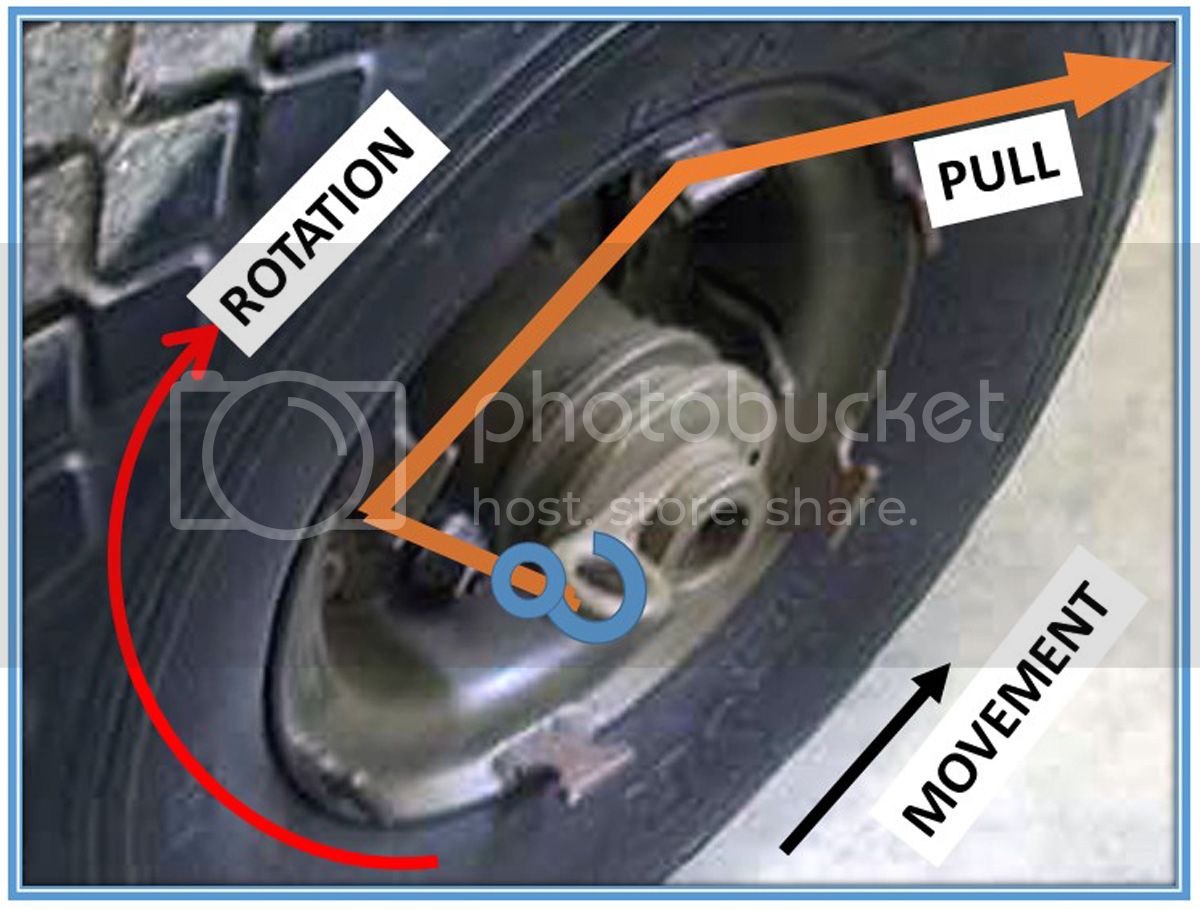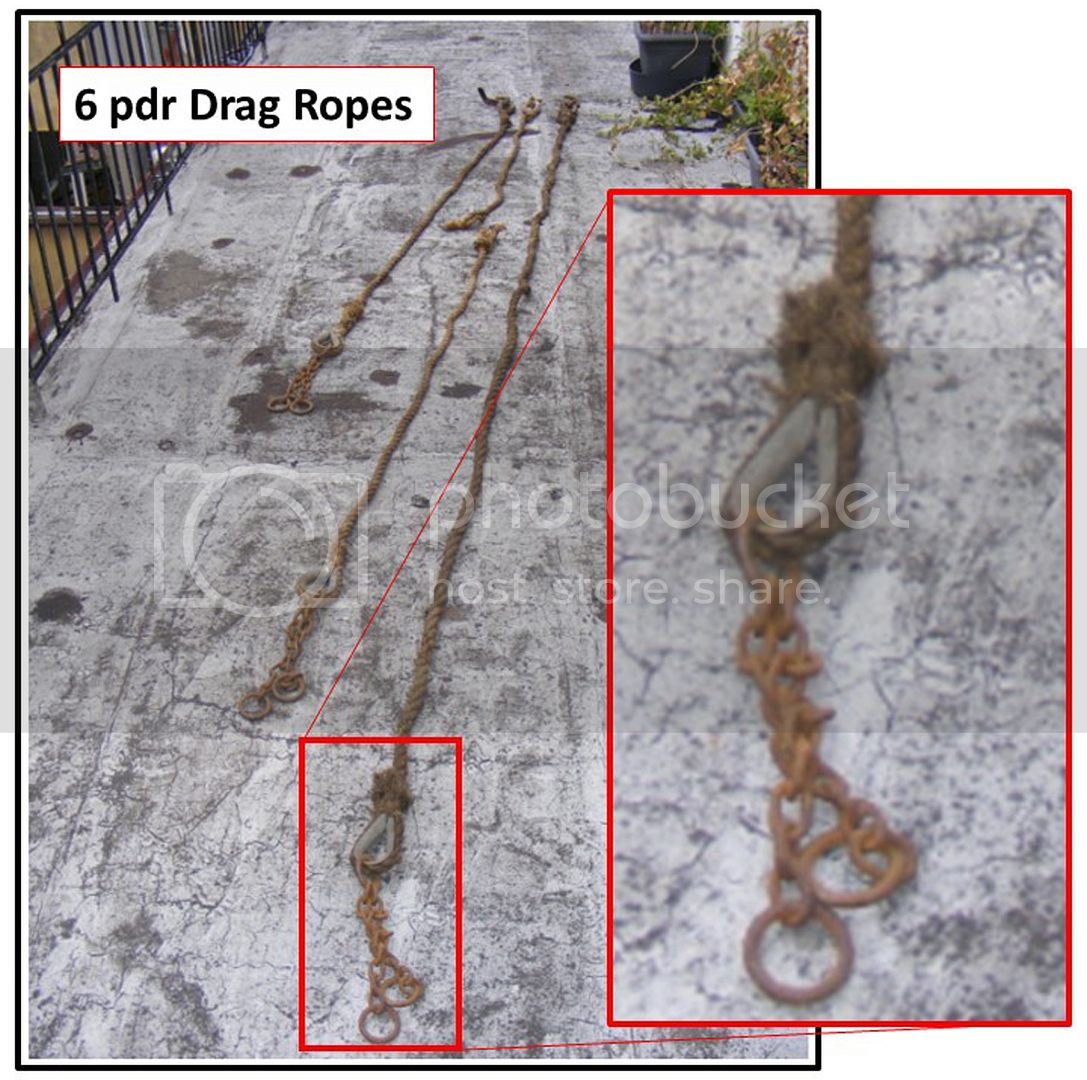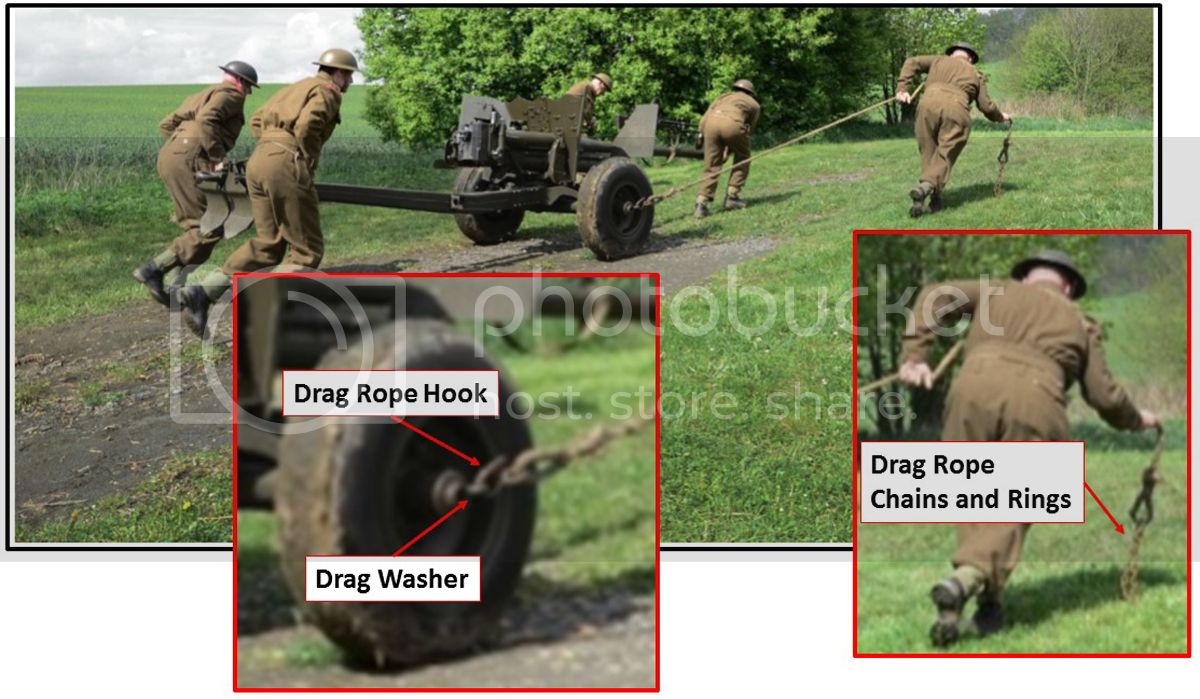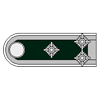Those tabs had to be pretty tough on ropes . . .
KL
Hosted by Darren Baker
Q: Purpose of Tabs on 6 pdr Rims?

KurtLaughlin

Joined: January 18, 2003
KitMaker: 2,402 posts
Armorama: 2,377 posts

Posted: Tuesday, January 06, 2015 - 05:35 AM UTC

ALBOWIE

Joined: February 28, 2006
KitMaker: 1,605 posts
Armorama: 1,565 posts

Posted: Tuesday, January 06, 2015 - 06:34 AM UTC
Quoted Text
Quoted TextSorry Paul but that is what they are for, Information from the The Garrison who are re-enactors of WW1 and WW2 Royal Artillery, a large number of them ex-gunners.
OK, I'm obviously not getting the picture here. :-)
So you wrap the rope around the tabs, rather like the rope on a windlass, anchoring one end to the hub and then pull the free end that you have let pay out the front thereby providing an extra torque to the wheel by virtue of the distance from the wheel hub to the rope strung across the tabs?
Wouldn't this mean you have to rewind the rope over the tabs every so often as you unwind the windlass?
If this is how it works, I can see the mechanical advantage, but it seems clumsy unless its used only in extremis and for very short distances.
If I haven't gotten it right yet, I'm obviously missing something and need pictures as well. :-)
Paul
Paul, I asked my ex Father in Law if he knew what they were for as he used 6 Pdrs during his national service and he may have the answer which was similar to that i heard years ago. The gun came with two ropes with a metal hook on one end. The hook was placed in the eyelet on the hub and the rope was fed down to an eyelet then fed round the tabs and back to the pulling team (two on each rope in his days - six man crew(or up depending on how much leverage was required). When they hauled the rope unwound until it came of the first tab it was around. They then repeated the process. They used this getting there guns onto and off the northern end of Stockton Beach (Newcastle Australia) where they fired them out to sea in the 50's. He siad the platoon had longer ropes and block and tackles for reall challenging terrain and on firm surface the tabs were not needed - just drag the gun.
This was designed for placing guns in awkward terrain where the towing vehicle could not get into a suitable position and was very strenuous. I am awaiting the user handbook for the six pounder which may have this illustrated
Al
SdAufKla

Joined: May 07, 2010
KitMaker: 2,238 posts
Armorama: 2,158 posts

Posted: Tuesday, January 06, 2015 - 09:46 AM UTC
I can easily see this procedure working on the 6 pdr. The rim-tabs (for want of a better name) are notched on their sides so as to hook the rope as it's being pulled.

This would seem to be possible and maybe quite effective to get the gun out of a rut or hole or to get it moving if stuck in mud. After the wheel rotated, the rope would slip off of each successive tab until it was only attached to the hub ring, still allowing for pulling in the normal manner. The crew could even use chocks and work the gun up a pretty steep slope (a foot or two at a time). An extreme measure, but workable.
However, the rim-tabs on the 25 pdr and 17 pdr hook TOWARDS the center / hub of the wheel and not outward or circumferential (as on the 6 pdr rims). It would seem to me that as soon as any tension was exerted on the ropes to turn the 25 pdr or 17 pdr wheels, the rope would slip off the backside of the rim-tab.
For this procedure to work on the 25 pdr pr 17 pdr, it would seem that the rim-tabs would have to be facing the opposite direction. That is, the hook side would have to be facing away from the center of the wheel.
I simply can't envision how this rope hauling assist would or could work on the 25 pdr or 17 pdr.

This would seem to be possible and maybe quite effective to get the gun out of a rut or hole or to get it moving if stuck in mud. After the wheel rotated, the rope would slip off of each successive tab until it was only attached to the hub ring, still allowing for pulling in the normal manner. The crew could even use chocks and work the gun up a pretty steep slope (a foot or two at a time). An extreme measure, but workable.
However, the rim-tabs on the 25 pdr and 17 pdr hook TOWARDS the center / hub of the wheel and not outward or circumferential (as on the 6 pdr rims). It would seem to me that as soon as any tension was exerted on the ropes to turn the 25 pdr or 17 pdr wheels, the rope would slip off the backside of the rim-tab.
For this procedure to work on the 25 pdr pr 17 pdr, it would seem that the rim-tabs would have to be facing the opposite direction. That is, the hook side would have to be facing away from the center of the wheel.
I simply can't envision how this rope hauling assist would or could work on the 25 pdr or 17 pdr.
Kevlar06


Joined: March 15, 2009
KitMaker: 3,670 posts
Armorama: 2,052 posts

Posted: Tuesday, January 06, 2015 - 01:29 PM UTC
Mike,
Perhaps the 25 and 17 lb guns used an "eye" instead of a "hook", at the end of the rope to attach to the tabs around the wheels? The US M1 and M2 carriages for the 57mm Gun (the same as the British 6 Pounder, but produced in the United States)seem to retain the ring on the hub, but not the hooks around the rim. Perhaps this is because the rim had openings? In Osprey's book on US anti-tank guns, the British designed 57mm appears to be the only AT gun in US inventory with a ring attached to the hub. I suspect the ring in US service was intended for hoisting the gun. The M2 had the rear caster wheel, so the crew could move it easier without dragging the trail. This is an interesting discussion-- are there any other Commonwealth artillery with the same hook/tab and eye configurations? VR, Russ
Perhaps the 25 and 17 lb guns used an "eye" instead of a "hook", at the end of the rope to attach to the tabs around the wheels? The US M1 and M2 carriages for the 57mm Gun (the same as the British 6 Pounder, but produced in the United States)seem to retain the ring on the hub, but not the hooks around the rim. Perhaps this is because the rim had openings? In Osprey's book on US anti-tank guns, the British designed 57mm appears to be the only AT gun in US inventory with a ring attached to the hub. I suspect the ring in US service was intended for hoisting the gun. The M2 had the rear caster wheel, so the crew could move it easier without dragging the trail. This is an interesting discussion-- are there any other Commonwealth artillery with the same hook/tab and eye configurations? VR, Russ
Wellsbourne

Joined: September 02, 2013
KitMaker: 93 posts
Armorama: 91 posts

Posted: Tuesday, January 06, 2015 - 04:32 PM UTC
I have to agree with the comments about the eye and tabs....you might like to know that the tabs were also on the "backside" too. These tabs are spaced halfway between the outer ones, same number only at a different angle. Historically, as gunners do not have "colours" (flags)...their guns were the colours.....so every attempt was made to recover a disabled gun in action.

KurtLaughlin

Joined: January 18, 2003
KitMaker: 2,402 posts
Armorama: 2,377 posts

Posted: Tuesday, January 06, 2015 - 04:35 PM UTC
Quoted Text
In Osprey's book on US anti-tank guns, the British designed 57mm appears to be the only AT gun in US inventory with a ring attached to the hub. I suspect the ring in US service was intended for hoisting the gun. The M2 had the rear caster wheel, so the crew could move it easier without dragging the trail.
The US used the "drag washers" for drag ropes as well. See page 26 here and page 44 for carriages with a caster wheel.
KL
Wellsbourne

Joined: September 02, 2013
KitMaker: 93 posts
Armorama: 91 posts

Posted: Tuesday, January 06, 2015 - 04:48 PM UTC
Quoted Text
Mike,
Perhaps the 25 and 17 lb guns used an "eye" instead of a "hook", at the end of the rope to attach to the tabs around the wheels? The US M1 and M2 carriages for the 57mm Gun (the same as the British 6 Pounder, but produced in the United States)seem to retain the ring on the hub, but not the hooks around the rim. Perhaps this is because the rim had openings? In Osprey's book on US anti-tank guns, the British designed 57mm appears to be the only AT gun in US inventory with a ring attached to the hub. I suspect the ring in US service was intended for hoisting the gun. The M2 had the rear caster wheel, so the crew could move it easier without dragging the trail. This is an interesting discussion-- are there any other Commonwealth artillery with the same hook/tab and eye configurations? VR, Russ
The eyed ring was known as a "drag washer"....I think the name describes it adequately...there was another type fitted to heavier guns and limbers, this was the loop washer. similar to the drag washer but with smaller ring above the drag eye. These were fitted to all artillery pieces, limbers and most wagons pre and post WW1. WW2 guns adopted the same principle, as it was necessary to be able to move guns when the terrain did not allow wheeled transport acess. If you look at the various photographs of guns used on tthe western front 1914 to 1918.....you can see the need for a method to move the guns.....some photo's show the crews using levers and ropes.....vehicles would be bogged down and horses unable to heave the equipment out of the morass. Various other methods were developed, larger tractor type wheels, the shoes (girdles) and fitting an extra rim to the wheel. The introduction of wheeled / tracked transport in the 1930's onwards required different thinking, but the earlier tyres were narrower and would allow the lugs on the rims to be used as fulcrum points for a lever.
Posted: Tuesday, January 06, 2015 - 09:08 PM UTC
Quoted Text
Paul, I asked my ex Father in Law if he knew what they were for as he used 6 Pdrs during his national service and he may have the answer which was similar to that i heard years ago.
I bow to the superior intelect! :-)
Can't beat first hand references.
Thanks Al!
Paul
SdAufKla

Joined: May 07, 2010
KitMaker: 2,238 posts
Armorama: 2,158 posts

Posted: Tuesday, January 06, 2015 - 09:17 PM UTC
Quoted Text
Quoted TextIn Osprey's book on US anti-tank guns, the British designed 57mm appears to be the only AT gun in US inventory with a ring attached to the hub. I suspect the ring in US service was intended for hoisting the gun. The M2 had the rear caster wheel, so the crew could move it easier without dragging the trail.
The US used the "drag washers" for drag ropes as well. See page 26 here and page 44 for carriages with a caster wheel.
KL
Thanks for the link, Kurt.
That helps clarify matters of nomenclature for the US gun and the crew drill procedures.
In the absence of confirmation of the British nomenclature, I'll go with the US Army terms in FM 23-75: Drag Ropes (with hooks); Drag Washers; Handspikes; Handspike Sockets (with pins).
Hopefully someone will find the similar manual for the British 6 pdr gun.
When the US adopted the gun for service and manufacture, it's clear that the "rim-tabs" from the original question were not added. Presumably because they were not thought to be so useful as to justify modifying the standard wheels that were used.
It would appear that these "rim-tabs" are more or less a uniquely British design feature.
Posted: Tuesday, January 06, 2015 - 09:39 PM UTC
Mike I accept your arguement on the 17 and 25pdr and so I will ask that the group to show me exactly how this works on the 25pdr and take pictures. This will take me some time as I am finding it hard to get up to the camp at the moment.
SdAufKla

Joined: May 07, 2010
KitMaker: 2,238 posts
Armorama: 2,158 posts

Posted: Tuesday, January 06, 2015 - 09:47 PM UTC
Quoted Text
Mike I accept your arguement on the 17 and 25pdr and so I will ask that the group to show me exactly how this works on the 25pdr and take pictures. This will take me some time as I am finding it hard to get up to the camp at the moment.
Thanks, Darren.
It's one of those curiosities that I really thought would be easy for someone to answer. There was obviously an intended purpose and method for using them that justified the effort and resources to add them to the wheels.
It's been very interesting to see how much discussion this has generated. It really is all about the history, sometimes.

ALBOWIE

Joined: February 28, 2006
KitMaker: 1,605 posts
Armorama: 1,565 posts

Posted: Wednesday, January 07, 2015 - 02:03 AM UTC
Quoted Text
I can easily see this procedure working on the 6 pdr. The rim-tabs (for want of a better name) are notched on their sides so as to hook the rope as it's being pulled.
This would seem to be possible and maybe quite effective to get the gun out of a rut or hole or to get it moving if stuck in mud. After the wheel rotated, the rope would slip off of each successive tab until it was only attached to the hub ring, still allowing for pulling in the normal manner. The crew could even use chocks and work the gun up a pretty steep slope (a foot or two at a time). An extreme measure, but workable.
However, the rim-tabs on the 25 pdr and 17 pdr hook TOWARDS the center / hub of the wheel and not outward or circumferential (as on the 6 pdr rims). It would seem to me that as soon as any tension was exerted on the ropes to turn the 25 pdr or 17 pdr wheels, the rope would slip off the backside of the rim-tab.
For this procedure to work on the 25 pdr pr 17 pdr, it would seem that the rim-tabs would have to be facing the opposite direction. That is, the hook side would have to be facing away from the center of the wheel.
I simply can't envision how this rope hauling assist would or could work on the 25 pdr or 17 pdr.
I can't vouch for the larger guns but the Australian gunners in the new guinea campaign hauled two full sized 25 pounders up the golden staircase on the kokoda track which must have taken days if not weeks.

RobinNilsson

Joined: November 29, 2006
KitMaker: 6,693 posts
Armorama: 5,562 posts

Posted: Wednesday, January 07, 2015 - 02:59 AM UTC
Quoted Text
Quoted TextI can easily see this procedure working on the 6 pdr. The rim-tabs (for want of a better name) are notched on their sides so as to hook the rope as it's being pulled.
This would seem to be possible and maybe quite effective to get the gun out of a rut or hole or to get it moving if stuck in mud. After the wheel rotated, the rope would slip off of each successive tab until it was only attached to the hub ring, still allowing for pulling in the normal manner. The crew could even use chocks and work the gun up a pretty steep slope (a foot or two at a time). An extreme measure, but workable.
However, the rim-tabs on the 25 pdr and 17 pdr hook TOWARDS the center / hub of the wheel and not outward or circumferential (as on the 6 pdr rims). It would seem to me that as soon as any tension was exerted on the ropes to turn the 25 pdr or 17 pdr wheels, the rope would slip off the backside of the rim-tab.
For this procedure to work on the 25 pdr pr 17 pdr, it would seem that the rim-tabs would have to be facing the opposite direction. That is, the hook side would have to be facing away from the center of the wheel.
I simply can't envision how this rope hauling assist would or could work on the 25 pdr or 17 pdr.
I can't vouch for the larger guns but the Australian gunners in the new guinea campaign hauled two full sized 25 pounders up the golden staircase on the kokoda track which must have taken days if not weeks.
Aussies were tough ;-)
SdAufKla

Joined: May 07, 2010
KitMaker: 2,238 posts
Armorama: 2,158 posts

Posted: Wednesday, January 07, 2015 - 03:30 AM UTC
Quoted Text
I can't vouch for the larger guns but the Australian gunners in the new guinea campaign hauled two full sized 25 pounders up the golden staircase on the kokoda track which must have taken days if not weeks.
I don't question that the guns were dragged and manhandled in some situations, up the Kokoda trail or otherwise. That this was done is quite clear.
I'm simply skeptical of the "windless" description that used the tabs welded on the rims. It would seem to be workable on the 6 pdr, but given the orientation of the tabs on the rims of the other guns, it seems to defy mechanics. There's something missing yet from our knowledge of the purpose and use of these things.
As to the guys who hauled those guns up the Kokoda trail, no amount of gizmos and gadgets could have made that job anything but a backbreaking grind. "Sweat and muscle and jungle work" as Zevon put it.
RonV

Joined: February 13, 2003
KitMaker: 143 posts
Armorama: 120 posts

Posted: Wednesday, January 07, 2015 - 09:54 AM UTC
FWIW, the 1940 Handbook for the 25-PR., Mark II on Carriage, 25 PR,
Mark I says" Ten hooks are welded under the curved edges of the (wheel) rim, five on each side, for the attachment of a manhandling drag rope".
Perhaps this allows some sense of credibility when discussing the same aspect on the 6-PR. I suspect that memories of trying manhandle the guns in the mud of WWI might have been a motivator.
Ron Volstad
Mark I says" Ten hooks are welded under the curved edges of the (wheel) rim, five on each side, for the attachment of a manhandling drag rope".
Perhaps this allows some sense of credibility when discussing the same aspect on the 6-PR. I suspect that memories of trying manhandle the guns in the mud of WWI might have been a motivator.
Ron Volstad
Posted: Wednesday, January 07, 2015 - 10:09 AM UTC
What might surprise some is that even the British 105mm light gun has these tabs on the wheels, I believe the 105 was the last gun to enter British service.
SdAufKla

Joined: May 07, 2010
KitMaker: 2,238 posts
Armorama: 2,158 posts

Posted: Wednesday, January 07, 2015 - 06:50 PM UTC
Quoted Text
FWIW, the 1940 Handbook for the 25-PR., Mark II on Carriage, 25 PR,
Mark I says" Ten hooks are welded under the curved edges of the (wheel) rim, five on each side, for the attachment of a manhandling drag rope".
Perhaps this allows some sense of credibility when discussing the same aspect on the 6-PR. I suspect that memories of trying manhandle the guns in the mud of WWI might have been a motivator.
Ron Volstad
Well, that is about as official a statement of intended purpose as we're likely to discover. Surely the author of the HB knew what he was talking about.
The orientation of the hooks still causes me to ponder how "the attachment of a manhandling drag rope" was supposed to have been done.
Thanks for looking that up, Ron.
The use of hand spikes and drag ropes to move artillery pieces into and out of battery, as well as for aiming was a longstanding historical procedure.
In my search for the answer to this question about the 6 pdr rim "hooks," I came across a very detailed 19th century set of cannon crew instructions which included the command to "Point." At this time, crewmen on opposite sides of the gun used handspikes under the rims of the wheels to adjust the final left of right defection of the gun. The gunner directed this adjustment by tapping his hand on one side of the cannon or the other as he sighted down the barrel. After "pointing," the command to "Fire" was given.
In these instructions, handspikes and ropes were also used to initially position the cannon, to move it back in battery after recoiling, etc.
The artillery, as a branch, obviously has a long tradition of using ropes and levers to move things about.
No doubt, these rim "hooks" are the vestigial remains of some of that tradition with its freshest memories still rooted in the Great War.
I would very much love to see a wartime photo of these hooks being employed to move one of the pieces discussed. Photos of the drag ropes being used are scarce, but they exist. However, I've yet to find a single photo of any crew using the hooks on the wheels for anything.
pseudorealityx

Joined: January 31, 2010
KitMaker: 2,191 posts
Armorama: 1,814 posts

Posted: Wednesday, January 07, 2015 - 08:09 PM UTC
For the 17 and 25 pounders, maybe the handbook is extremely literal in it's description.
With the curved orientation of the rim tabs, "for the attachment of a manhandling [u]drag[/u] rope"
If the wheel wasn't in a position to rotate (why, I have no idea), but could literally be dragged. In this case, the orientation is correct.
With the curved orientation of the rim tabs, "for the attachment of a manhandling [u]drag[/u] rope"
If the wheel wasn't in a position to rotate (why, I have no idea), but could literally be dragged. In this case, the orientation is correct.

Frenchy

Joined: December 02, 2002
KitMaker: 12,719 posts
Armorama: 12,507 posts

Posted: Wednesday, January 07, 2015 - 08:50 PM UTC
Quoted Text
In my search for the answer to this question about the 6 pdr rim "hooks," I came across a very detailed 19th century set of cannon crew instructions which included the command to "Point."
I guess this could be the manual you're talking about

H.P.
BigfootV

Joined: December 24, 2005
KitMaker: 1,624 posts
Armorama: 994 posts

Posted: Wednesday, January 07, 2015 - 09:55 PM UTC
Hello Mike,
Just found this photo. May help.
http://www.britishskytours.com/images/HORSA%20ATG.jpg
Crew loading a 17 pdr. on to a Horsa glider.
See ya in the funnies................

Just found this photo. May help.
http://www.britishskytours.com/images/HORSA%20ATG.jpg
Crew loading a 17 pdr. on to a Horsa glider.
See ya in the funnies................



ALBOWIE

Joined: February 28, 2006
KitMaker: 1,605 posts
Armorama: 1,565 posts

Posted: Thursday, January 08, 2015 - 01:29 AM UTC
Quoted Text
Hello Mike,
Just found this photo. May help.
http://www.britishskytours.com/images/HORSA%20ATG.jpg
Crew loading a 17 pdr. on to a Horsa glider.
See ya in the funnies................

6 Pdr

AikinutNY

Joined: October 21, 2003
KitMaker: 683 posts
Armorama: 630 posts

Posted: Thursday, January 08, 2015 - 04:43 AM UTC
Does not look like the rope is on the top tab? Looks like it goes straight to the hub.

Nylonathatep

Joined: September 27, 2007
KitMaker: 58 posts
Armorama: 56 posts

Posted: Thursday, January 08, 2015 - 12:16 PM UTC
Quoted Text
...
Well, that is about as official a statement of intended purpose as we're likely to discover. Surely the author of the HB knew what he was talking about.
The orientation of the hooks still causes me to ponder how "the attachment of a manhandling drag rope" was supposed to have been done.
...
Given that there are hooks on both the inside and outside of the wheel, the obvious thing to do would be to tie a loop in the end of the rope, something like a bowline, place the knot at the center of the tyre tread, run the rope down the inside of the tyre and around the hook, back up over the tread and down the outside and around a hook and back to the knot. The free end can then be run over the top of the wheel to pull the gun along a short distance. This would also give greater mechanical advantage.
Different gun, a 6 inch I believe, but the same idea:
http://handle.slv.vic.gov.au/10381/199146
If you have a look at the high-res download version the right rope is secured through the spokes somehow, maybe a hook or something, just visible past the man's left shoulder.
SdAufKla

Joined: May 07, 2010
KitMaker: 2,238 posts
Armorama: 2,158 posts

Posted: Thursday, January 08, 2015 - 08:07 PM UTC
That's a great photo. I think this might actually be the "text book" answer.
From the looks of it, the drag rope in the photo appears to have eyelets spliced in its end just for this purpose. The crew may also be using some design-purpose link passed through the spokes for the rope to be hooked to.
Here is a photo of a set of 6 pdr drag ropes recovered in Czechoslovakia with a gun that has been restored.

Note the pair of short chains with rings on them. These may well have been intended to serve the same purpose as the spliced eyelets in the rope in your photo Michael.
Here are the same ropes along with the restored gun being dragged by the reenactors at a living history display:

You can see the hooks on the other ends of the ropes for the drag washers.
Of course, this assumes that these ropes are original to the 6 pdr gun (always a concern with post-war reenactor portrayals), but in the absence of information to the contrary, I think this is the answer.
It seems a bit Heath Robinson (or Rube Goldberg, as we Americans would say), but the information seems to fit.
Thanks for taking the time to look up and post the photo, Michael!
From the looks of it, the drag rope in the photo appears to have eyelets spliced in its end just for this purpose. The crew may also be using some design-purpose link passed through the spokes for the rope to be hooked to.
Here is a photo of a set of 6 pdr drag ropes recovered in Czechoslovakia with a gun that has been restored.

Note the pair of short chains with rings on them. These may well have been intended to serve the same purpose as the spliced eyelets in the rope in your photo Michael.
Here are the same ropes along with the restored gun being dragged by the reenactors at a living history display:

You can see the hooks on the other ends of the ropes for the drag washers.
Of course, this assumes that these ropes are original to the 6 pdr gun (always a concern with post-war reenactor portrayals), but in the absence of information to the contrary, I think this is the answer.
It seems a bit Heath Robinson (or Rube Goldberg, as we Americans would say), but the information seems to fit.
Thanks for taking the time to look up and post the photo, Michael!
AFVFan

Joined: May 17, 2012
KitMaker: 1,980 posts
Armorama: 1,571 posts

Posted: Friday, January 09, 2015 - 03:04 AM UTC
It wouldn't surprise me at all to find out one of those guys on the ropes was the first to envision the concept of a self propelled gun! 

 |











